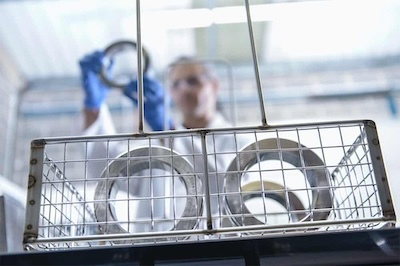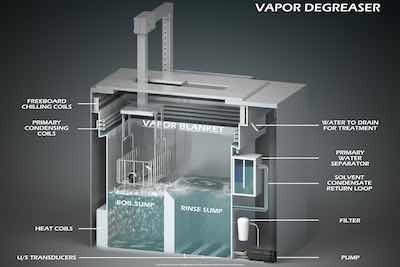Vapor degreasing is a crucial method in various industrial operations for the precision cleaning of metal components.
 Elizabeth NorwoodWhen used with modern cleaning fluids, it delivers optimal cleaning quality and speed with minimal risk of part damage. However, the landscape of these cleaning solutions has evolved significantly over the years.
Elizabeth NorwoodWhen used with modern cleaning fluids, it delivers optimal cleaning quality and speed with minimal risk of part damage. However, the landscape of these cleaning solutions has evolved significantly over the years.
Historically, n-Propyl Bromide (nPB) was a popular choice, but mounting environmental concerns and stringent regulations have prompted many companies to explore more sustainable alternatives. This transition necessitates careful planning to ensure a seamless conversion that maintains effective cleaning processes while avoiding future complications.
Regulatory Landscape
The move from nPB to more eco-friendly cleaning fluid reflects changing attitudes within the industry. nPB has come under intense scrutiny from regulatory agencies. The U.S. Environmental Protection Agency (EPA) added nPB to its Toxic Substance Control Act (TOSCA) list in 2018, signaling growing concerns about its environmental and health impacts.
By August 2020, the EPA had taken a firm stance, officially declaring that nPB poses an unreasonable risk to human health and recommending restrictions on its use as a cleaner or degreaser. This marked a significant turning point in the regulatory landscape, with a comprehensive EPA ban on nPB thought to be imminent.
The global perspective on nPB is also changing rapidly. Since 2020, nPB has either been phased out or banned in Europe, aligning with stringent environmental regulations in the region. Furthermore, many other countries are poised to follow suit, indicating the inevitable decline of nPB's worldwide use in critical cleaning applications.
Moving Forward
 Conduct in-lab pre-testing on sample parts with various replacement fluids and methods to identify the most effective combinations.With the changing regulatory landscape, it is important to take proactive steps to replace nPB with sustainable cleaning fluids that pose fewer hazards to workers and the environment. Modern vapor degreasing fluids provide consistent cleaning quality, cost-effectiveness, and improved throughput. They also exhibit enhanced toxicity profiles, making them a safer choice than nPB.
Conduct in-lab pre-testing on sample parts with various replacement fluids and methods to identify the most effective combinations.With the changing regulatory landscape, it is important to take proactive steps to replace nPB with sustainable cleaning fluids that pose fewer hazards to workers and the environment. Modern vapor degreasing fluids provide consistent cleaning quality, cost-effectiveness, and improved throughput. They also exhibit enhanced toxicity profiles, making them a safer choice than nPB.
nPB replacement cleaning fluids undergo rigorous laboratory testing and analysis to ensure their cleaning outcomes are dependable, often exceeding those achieved with nPB. They effectively remove various contaminants from parts, including machining oils, greases, lubricants, polishing pastes, adhesives, waxes, marking inks, and fingerprints.
Furthermore, many modern vapor degreasing fluids, despite their exceptional solvency to efficiently dissolve contaminants, are carefully formulated to avoid harming delicate part substrates or materials.
5 Steps to Change
Before replacing nPB inside a vapor degreaser, it is important to follow five essential steps to ensure the transition is seamless. This should be completed with the help of a specialized precision cleaning partner who can schedule an on-site audit.
- Initiate an on-site cleaning assessment to gather vital information about specific requirements, parts sizes, substrates, contamination, and equipment.
- Identify suitable nPB replacements by assessing gathered information and matching a new cleaning fluid to the cleaning objectives.
- Conduct in-lab pre-testing on sample parts with various replacement fluids and methods to identify the most effective combinations.
- Conduct on-site testing to assess replacement performance in an operational environment for cleaning efficiency and quality.
- Explore customized fluid solutions tailored to the facility's needs if initial testing does not meet requirements.
Comprehensive Cleaning Process
Once the steps have been completed and a replacement has been found, it is important to plan the switch and conduct a thorough cleaning, neutralization, and passivation process of the vapor degreaser before the conversion. Consulting with a critical cleaning expert is advised to ensure it is undertaken correctly.
Because nPB has a higher boiling point than many modern replacement fluids, traces of nPB can remain within the system when the lower-boiling replacement solvent evaporates. Over time, the stabilizer in the nPB will dissipate, with the remaining nPB turning acidic, leading to corrosion within the machinery and a decline in the degreaser's overall performance.
When cleaning the vapor degreaser, it is important to follow strict safety protocols, including the use of personal protective equipment. Furthermore, having two individuals present during the process and ensuring adequate ventilation are essential safety measures. The procedure may take several days, so early planning is key.
Start by draining the degreaser. Meticulous removal of all used solvents is crucial, as thoroughly emptying residual solvents from water separators, spray reservoirs, filters, and other pipes. All filter cartridges should also be removed and drained.
It is essential that all solvent vapors are evacuated before entering or reaching into the vapor degreaser. Solvent fumes pose serious inhalation hazards, as they are heavier than air and can concentrate in confined spaces like degreaser interiors. Strict safety protocols are essential to prevent vapor accumulation and ensure air quality before maintenance.
Use a mild soap or non-abrasive scouring powder to clean any walls or surfaces that encounter the solvent. Attention should be given to rust removal, particularly in the condensate trough and water separator. It is important not to use steel brushes or sponges that may cause scratching or leave embedded particles on the stainless-steel surfaces of the degreaser. Once cleaned, rinse all surfaces with clean water and completely drain the system.
Effective Neutralization and Re-Passivation
 If nPB turns acidic, it can lead to corrosion within the machinery and a decline in the degreaser's overall performance.The next step after cleaning is neutralization. Fill the degreaser with warm water, ensuring coverage of the primary condensing coils. If the degreaser cannot support the weight and pressure of water, filling it above the condensate rinse sump is necessary. Adequate water filling is crucial for areas where the solvent contacts, whether in liquid or vapor form, including spray reservoirs, water separators, filters, and any other pipework.
If nPB turns acidic, it can lead to corrosion within the machinery and a decline in the degreaser's overall performance.The next step after cleaning is neutralization. Fill the degreaser with warm water, ensuring coverage of the primary condensing coils. If the degreaser cannot support the weight and pressure of water, filling it above the condensate rinse sump is necessary. Adequate water filling is crucial for areas where the solvent contacts, whether in liquid or vapor form, including spray reservoirs, water separators, filters, and any other pipework.
Wearing protective eyewear, add 1-1/2 ounces of sodium bicarbonate (or soda ash) per gallon of water and thoroughly mix it into the solution. Heat the water to approximately 120°F (50°C), activating the pumps and spray lances to circulate the solution throughout the system. This will ensure effective metal neutralization takes place. In cases where the degreaser cannot be filled above the cooling coils, spraying or flushing alkaline water over the condensate cooling coils and degreaser walls above the liquid level is necessary.
Frequently evaluating the water's pH is vital to preserve alkalinity. If the pH drops below alkaline levels, more sodium bicarbonate, or soda ash, must be introduced. While heating and circulating the solution, monitor and adjust pH to maintain the correct level throughout the process.
Next, completely drain the water from the degreaser, water separator, and spray wand before refilling with fresh, clean water, covering the primary condensing coils. Running pumps and circulating rinse water for 30 minutes, with repeated cycles, to ensure neutral water.
The next step is re-passivation, which involves preparing a 7% (by volume) citric acid solution by slowly introducing citric acid into water. Take caution not to pour water into the citric acid, as this could cause uncontrolled reactions.
Once the diluted citric acid solution is prepared, fill the degreaser to a level above the primary condenser coils. Ensuring the citric acid contacts all surfaces exposed to solvents or vapors is critical for effective passivation.
With the degreaser filled, turn on the heating system to increase the citric acid solution temperature to 120-160°F. Proper heating facilitates the passivation reaction between the metal surfaces and the citric acid.
After heating, activate pumps to circulate the citric acid through all internal components, including piping, filters, reservoirs, and water separators. Continue circulation for approximately two hours to fully expose all internal surfaces to the passivation solution. Then turn off the heating system and stop circulation to proceed to the next stage - rinsing.
Allow the system to cool, then drain the citric acid solution from the degreaser and all associated components, including piping, filter housing, spray reservoirs, and the water separator.
Refilling the degreaser and all components with fresh rinse water and circulating it for approximately 30 minutes is necessary.
Subsequently, it is recommended to drain all rinse water from the degreaser and its components, followed by a repeat rinsing step to ensure thorough cleaning.
Thorough Completion
The last step involves the complete drainage of rinse water and thoroughly drying the entire degreaser. Circulating dry air through the system overnight is important before resetting all thermostats (liquid and vapor); adding fresh solvent and verifying proper degreaser functionality is essential before resuming operations.
Finally, properly dispose of all chemicals, solutions, and rinse water following local, state, and federal hazardous waste regulations.
Throughout the conversion process, it is vital to extract a sample approximately three weeks in and analyze it for any remaining traces of nPB. Detecting such traces necessitates prompt solvent disposal and refilling with the chosen new fluid to prevent the gradual deterioration of the degreaser, typically occurring within approximately 12 months.
The Future
The impending ban on nPB highlights the urgency of transitioning to safer and more environmentally sustainable cleaning solutions within vapor degreasers. By adhering to these comprehensive steps and collaborating with knowledgeable cleaning partners, production facilities can navigate this transition seamlessly. This ensures compliance with evolving regulations, safeguarding the health and safety of their workforce and the environment.
Elizabeth Norwood is a Senior Chemist at MicroCare, LLC, which offers precision cleaning solutions. She has been in the industry for more than 25 years and holds a B.S. in Chemistry from the University of St. Joseph. Norwood researches, develops, and tests cleaning-related products. She currently has one patent issued and two pending for her work. For more information, visit www.microcare.com.



































